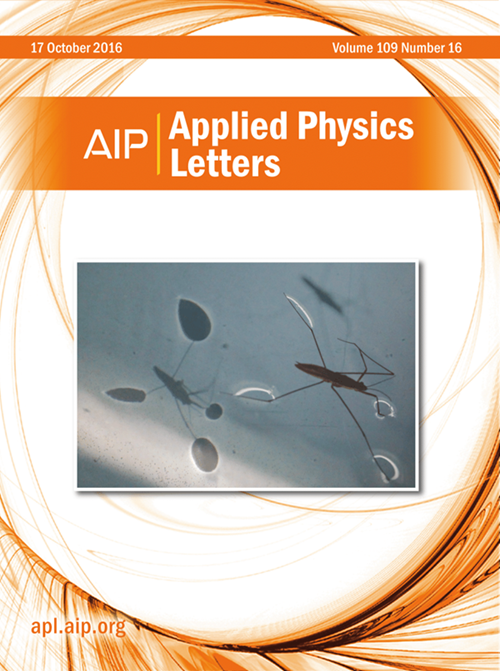高性能四端钙钛矿/硅串联太阳能电池用缺陷钝化宽禁带钙钛矿薄膜
IF 3.6
2区 物理与天体物理
Q2 PHYSICS, APPLIED
引用次数: 0
摘要
宽带隙钙钛矿太阳能电池(PSCs)由于具有形成高质量、稳定薄膜的潜力,可以显著提高硅基串联太阳能电池(TSCs)的效率,因此受到了广泛的关注。然而,这些器件的性能受到结晶不良、WBG钙钛矿薄膜中高固有陷阱密度和非辐射复合(主要是由于体积缺陷)的阻碍。为了应对这些挑战,我们引入了3-吡啶基甲基碘化铵(3-PyAI)作为添加剂来钝化钙钛矿薄膜内部的固有缺陷。3-PyAI的加入通过与非配位Pb2+离子和FA+阳离子的相互作用显著降低了缺陷诱导的非辐射重组。所得的3- pyai修饰的钙钛矿膜显著提高了结晶度,增大了晶粒尺寸,提高了体质量,并最大限度地减少了非辐射复合缺陷。因此,无甲基铵的Cs0.22FA0.78Pb(I0.85Br0.15)3 PSCs的功率转换效率(PCE)为21.75%,远高于控制装置的19.60%。在此基础上,我们集成了硅底太阳能电池,开发了四端(4T) TSC,实现了30.52%的冠军PCE。这项工作解决了wbg - psc的关键性能瓶颈,并为实现高效tsc建立了一个强大的框架,代表了下一代光伏技术的实际实施迈出了重要的一步。本文章由计算机程序翻译,如有差异,请以英文原文为准。
Defect passivated wide-bandgap perovskite films for high performance four-terminal perovskite/silicon tandem solar cells
Wide-bandgap (WBG) perovskite solar cells (PSCs) have garnered significant attention due to their potential to form high-quality, stable films, which can significantly enhance the efficiency of silicon-based tandem solar cells (TSCs). However, the performance of these devices is hindered by poor crystallization, a high intrinsic trap density in the WBG perovskite film, and nonradiative recombination, primarily due to bulk defects. In response to these challenges, we introduce 3-pyridinylmethylammonium iodide (3-PyAI) as an additive to passivate intrinsic defects within the bulk of the perovskite film. The addition of 3-PyAI significantly lowers defect induced nonradiative recombination by developing interactions with uncoordinated Pb2+ ions and FA+ cations. The resulting 3-PyAI-modified perovskite film significantly improves crystallinity, enlarges grain size, enhances bulk quality, and minimizes nonradiative recombination defects. Consequently, the methylammonium-free Cs0.22FA0.78Pb(I0.85Br0.15)3 PSCs demonstrate power conversion efficiency (PCE) of 21.75%, much higher than that of the control device at 19.60%. Building on this advance, we integrated a silicon bottom solar cell, developing a four-terminal (4T) TSC that achieved a champion PCE of 30.52%. This work addresses the critical performance bottlenecks in WBG-PSCs and establishes a robust framework for realizing high-efficiency TSCs, representing a significant step toward the practical implementation of next-generation photovoltaic technologies.
求助全文
通过发布文献求助,成功后即可免费获取论文全文。
去求助
来源期刊

Applied Physics Letters
物理-物理:应用
CiteScore
6.40
自引率
10.00%
发文量
1821
审稿时长
1.6 months
期刊介绍:
Applied Physics Letters (APL) features concise, up-to-date reports on significant new findings in applied physics. Emphasizing rapid dissemination of key data and new physical insights, APL offers prompt publication of new experimental and theoretical papers reporting applications of physics phenomena to all branches of science, engineering, and modern technology.
In addition to regular articles, the journal also publishes invited Fast Track, Perspectives, and in-depth Editorials which report on cutting-edge areas in applied physics.
APL Perspectives are forward-looking invited letters which highlight recent developments or discoveries. Emphasis is placed on very recent developments, potentially disruptive technologies, open questions and possible solutions. They also include a mini-roadmap detailing where the community should direct efforts in order for the phenomena to be viable for application and the challenges associated with meeting that performance threshold. Perspectives are characterized by personal viewpoints and opinions of recognized experts in the field.
Fast Track articles are invited original research articles that report results that are particularly novel and important or provide a significant advancement in an emerging field. Because of the urgency and scientific importance of the work, the peer review process is accelerated. If, during the review process, it becomes apparent that the paper does not meet the Fast Track criterion, it is returned to a normal track.
 求助内容:
求助内容: 应助结果提醒方式:
应助结果提醒方式:


